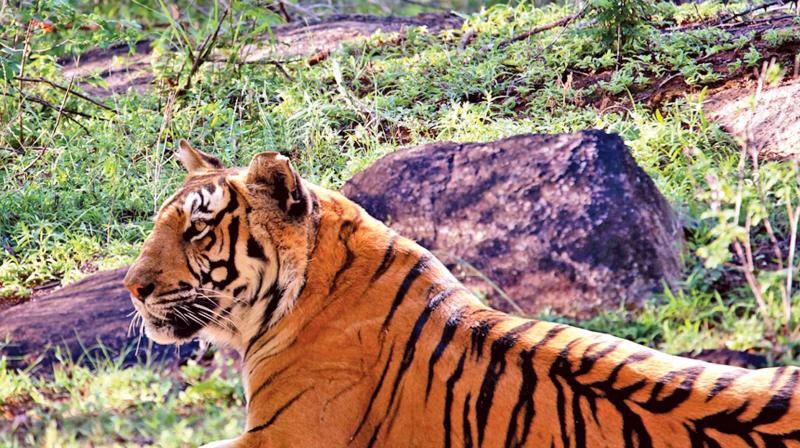Perfect 10 for Mudumalai Tiger Reserve
Mudumalai lives up to its name as tiger reserve, but conservation challenges continue.

Ooty: Come Sunday (July 29), the globe will be observing International Tiger Day to signify the importance of tiger conservation. For Mudumalai Tiger Reserve (MTR) it is extra special this year as it has completed a decade of existence as tiger reserve after being elevated to tiger reserve status from the erstwhile Mudumalai wildlife sanctuary.
In 2008 there was widespread objections to such tiger reserve status as it was feared by the protesters that it would bring untold restrictions in and around the Mudumalai woods and cripple tourism and normal livelihood activities.
Dr Rajiv K. Srivastava, the first field director of MTR in 2008, effectively tackled the oppositions and objections to lay the foundation for Mudumalai woods to blossom into a glowing tiger land. Now, MTR has grown to be a top flight tiger reserve in India as recent studies on management effective evaluation (MEE) done by the National Tiger Conservation Authority has placed the MTR in "very good" category for its best maintenance.
MTR has added 367.59 sq km into its fold as buffer zone thus extending its original limits of 321 sq km. (core area) to now around 688.59 sq km.
Though there were about 30 to 35 tigers during its formation period as tiger reserve, now, the situation is sparkling now as the tiger population has shown phenomenal increase in MTR.
At present, tiger population is around 60 to 65 tigers in the core zone and around 35 to 40 in buffer zone in MTR, said A.K. Ulaghanathan, the current field director of MTR.
Efficient tiger reserve management efforts coupled with superior anti-poaching measures over the decade are the reasons for MTR's performance. There are 27 anti-poaching camps across MTR with about five staff in each camp to patrol the jungles. “We have regular pre and post monsoon habitat evaluation to take corrective actions and regular camera traps to follow the movement of tigers,” he noted. When asked about the dragging relocation process of about six jungle hamlets in the MTR core zone, Mr Ulaga nathan said the process is underway to relocate the near 200 families living in the 6 hamlets.
He hoped that it would be completed by this year end. Mr N. Mohanraj, adviser, WWF-India, who is also the Honorary Wildlife Warden for MTR, said there is a good breeding population of tigers in MTR woods. The spill over population of tigers has now moved to the buffer zone.
On the challenging issues to be addressed in MTR, he said that spread of invasive weeds like lantenna that is destroying the habitat, unregulated tourism in the buffer zone and the movement of more vehicles are the things to be addressed. “Though tourist vehicle movement from Ooty to MTR via Kallhatti on the descending way is controlled to appreciable limits by diversion of traffic, the uphill traffic is on the increase which play spoilt sport with wildlife ecology, serenity and animal crossing,” he noted.
Genetic signature key to keep track of tigers
Researchers in wildlife biology are pitching for continuance of research for establishing the genetic signature (DNA profile) of tigers in MTR to keep track on the history of individual tigers in the MTR as the initial research in this regard failed to take off further.
Stating that the Department of Zoology and Wildlife Biology (DZWB) at the Government Arts College in Ooty was entrusted with research related to tiger DNA profiling way back in 2012, Dr B. Ramakrishnan, assistant professor at DZWB and principal investigator of the project then, said that the project ran for nearly four years during which DZWB researchers standardized the methods of tiger DNA profiling using tiger scat and other DNA source materials of tiger.
“Though DZWB, in tie up with the forest department, established the genetic signature of around 23 tigers, the project could not be pursued further for the past couple of years due to want of funds,” he noted and added that though camera trap technology is being used to study the individual tigers in the woods, it requires high level skills for precision.
But, DNA profiling technology is non-invasive that will be helpful to track the history and movement of tigers as the DNA code of two tigers are non-identical, he pointed.
“In camera trap technology the stripe pattern is the reliable source to keep track of the tiger. Suppose, in case of a tiger death or poaching, only the skeletal remains are available and not the skin, then the camera trap technology would not help to trace the history and identity the tiger.
If genetic signature of tiger is established, even the skeletal remains or tissue or blood stain is enough to decode the genetic signature to establish the identity of the dead tiger. Also, the DNA profiling, over the time, will help study the tiger-corridor in the jungles, especially in the fringe areas. Hence, the continuance of research to establish genetic signature of the tigers is essential in the modern era,” Dr Ramakrishnan explained.

